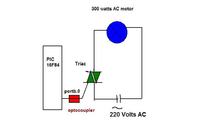Green_Peace09
Newbie level 3

Hi Everybody,
I have a problem that I could not solve. For a project, I am controlling an 180 watts and 220 Volts AC motor by Using a PIC16F84A. But I also want to stop the motor when it is overloaded, without using a fuse. For example, when the motor is overloaded, there will be much current flow in the circuit. How can I sense this much current, transmit this data to the PIC ? Could you please help me for this ?
Kind regards.
I have a problem that I could not solve. For a project, I am controlling an 180 watts and 220 Volts AC motor by Using a PIC16F84A. But I also want to stop the motor when it is overloaded, without using a fuse. For example, when the motor is overloaded, there will be much current flow in the circuit. How can I sense this much current, transmit this data to the PIC ? Could you please help me for this ?
Kind regards.






